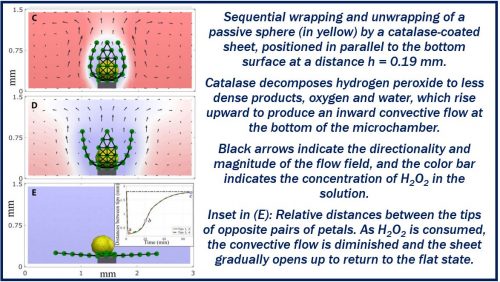Researchers have created a two-dimensional, shape-changing sheet that moves about like a flying carpet. It moves autonomously in a reactant-filled fluid. It is what they call a ‘catalytic flying carpet.’ When we hear ‘magic carpet,’ we think of the tales from ‘One Thousand and One Nights.’ We imagine not only a carpet that flies but also one that waves, flaps, and changes shape.
The creators of the catalytic flying carpet wrote about their work in the journal Science Advances (citation below). The authors were Abhrajit Laskar, Oleg E. Shklyaev, and Anna C. Balazs. They are all from the University of Pittsburgh’s Swanson School of Engineering (Pitt Swanson Engineering).
Catalyst – Catalytic: A catalyst is a chemical or substance that speeds up a chemical reaction without undergoing any chemical change itself. In business, politics, and some other contexts, the term may refer to a person/thing that precipitates an event. ‘Catalytic’ is the adjective of the noun ‘catalyst.’ Catalytic means involving or relating to the action of a catalyst.
In chemistry, its long been a challenge
Principal investigator, Dr. Balazs, the John A. Swanson Chair and Distinguished Professor of Chemical and Petroleum Engineering, explained:
“It’s long been a challenge in chemistry to create a non-living object that moves on its own within an environment, which in turn alters the object’s shape, allowing it to carry out brand new tasks, like trapping other objects.”
“Researchers previously have made chemically active patches on a surface that could generate fluid flow, but the flow didn’t influence the location or shape of the patch. And in our own lab we’ve modeled spherical and rectangular particles that can move autonomously within a fluid-filled microchamber.”
“But now we have this integrated system that utilizes a chemical reaction to activate the fluid motion that simultaneously transports a flexible object and “sculpts” its shape, and it all happens autonomously.”
The researchers accomplished this feat of reconfiguration and self-propulsion by covering the flexible sheet with a coating of catalysts. The sheet is about the width of a strand of human hair.

Cascade of catalytic reactions
They initiated the motion and shape-changing of the catalytic flying carpet by adding reactants to the surrounding fluid.
Dr. Balazs said:
“To best of our knowledge, this is the first time these catalytic chemical reactions have been applied to 2D sheets to generate flows that transform these sheets into mobile, 3D objects.”
The team created a useful cascade of catalytic reactions by placing different catalysts on specific parts of the sheet and controlling the type and amount of reactants in the fluid. In the cascade, one reactant broke down an associated chemical, which subsequently became a reactant for the next set of catalytic reactions.
According to a press release by Pitt Swanson Engineering:
“Adding different reactants and designing appropriate configurations of the sheet allows for a variety of actions – in this study, enwrapping an object, making a flapping motion, and tumbling over obstacles on a surface.”
Converting chemical energy into shape change and movement
Dr. Oleg E. Shklyaev, a Post-Doctoral Associate, said:
“A microfluidic device that contains these active sheets can now perform vital functions, such as shuttling cargo, grabbing a soft, delicate object, or even creeping along to clean a surface.”
“These flexible micro-machines simply convert chemical energy into spontaneous reconfiguration and movement, which enables them to accomplish a repertoire of useful jobs.”
If you cut the sheet into a four-petal flower shape, and place it on the surface of the microfluidic device, it is possible to ‘program’ the petals’ chemistry to open and close individually. This then creates gates that carry out logic operations. It also generates particular fluid flows that transport particles throughout the device, Dr. Laskar added.
Dr. Laskar explained:
“For example, like a catcher’s mitt you can use the petals of the flower to trap a microscopic ball and hold it for a finite time, then initiate a new chemical reaction on a different set of petals so that the ball moves between them in a chemically-directed game of catch.”
“This level of spatial and temporal control allows for staged reactions and analyses that you otherwise couldn’t perform with non-deformable materials.”
Other experiments
The researchers also placed the catalyst on different parts of the sheet to create specific movements. When they placed the catalyst just on the body of the sheet, it moved eerily like an inchworm.
When they placed obstacles in front of the coated sheet, it tumbled over them and continued moving. In other words, it was able to traverse bumpy terrain.
Next step – using multiple sheets
Dr. Balazs said:
“This research gives us further insight into how chemistry can drive autonomous, spontaneous actuation and locomotion in microfluidic devices. Our next task is to explore microfabrication by using the interaction and self-organization of multiple sheets to bring them together into specific architectures designed to perform complex, coordinated functions.”
“Also, by experimenting with different stimuli such as heat and light, we can design mobile, 3D micro-machines that adapt their shape and action to changes in the environment. This level of responsive behavior is vital to creating the next generation of soft robotic devices.”
Citation
“Designing self-propelled, chemically active sheets: Wrappers, flappers, and creepers,” Abhrajit Laskar, Oleg E. Shklyaev, and Anna C. Balazs. Science Advances 21 Dec 2018: Vol. 4, no. 12, eaav1745. DOI: 10.1126/sciadv.aav1745.
Video – Catalytic Flying Carpet
This ScienceVio video shows the catalytic flying carpet in action.
